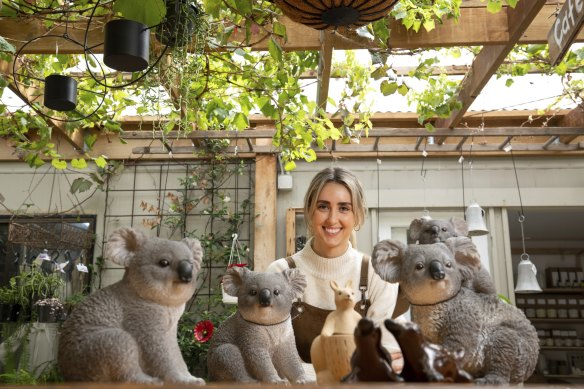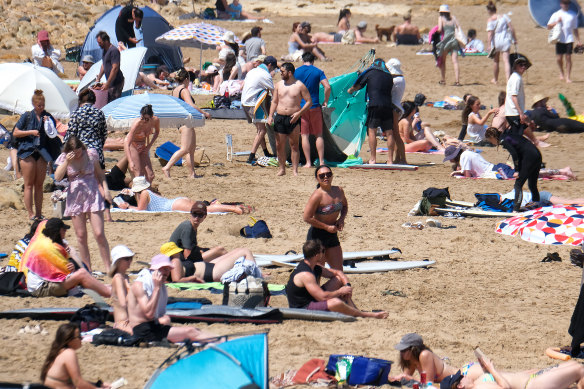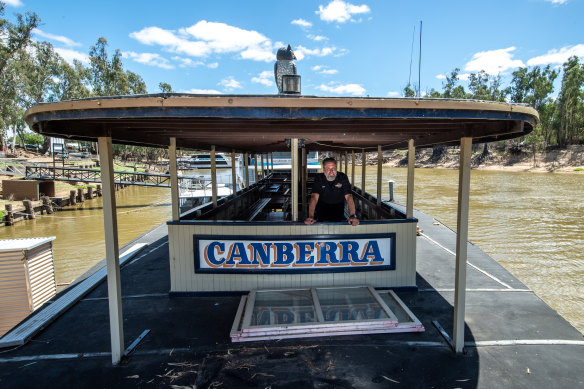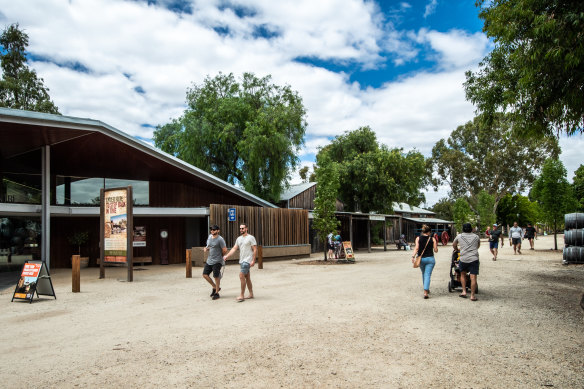Summertime, and the travelling is easier (at last)
Key points
- International tourism is returning to Victoria.
- Coastal tourism operators have had a bumper summer with high demand.
- Flood-stricken areas struggled with lower visitation during the summer peak.
If the bumper sales of cute kangaroos and koala souvenirs are anything to go by, Victoria’s international tourism numbers are bouncing back from the pandemic-driven doldrums.
Talia Klein, who runs Poppie’s Nursery and Cafe in Anglesea, south-west of Melbourne, said she had sold out of Aussie-themed gifts.
“People were obviously travelling from overseas and wanted to take gifts back,” she said.
Talia Klein at Poppie’s Nursery and Cafe in Anglesea has noticed that international tourists are back and has had to order more stock of kangaroo and koala souvenirs.Credit:Penny Stephens
And the stats back that up, with international arrivals up more than 500 per cent year on year.
Melbourne Airport processed 766,439 international travellers in December compared with 135,823 in the same month in 2021. The airport said the overseas arrivals hit 71 per cent of the December 2019 pre-COVID number.
While coastal tourism operators are surfing the wave of demand from foreign and domestic holidaymakers during the first summer without pandemic restrictions in three years, the sector still faces challenges. Staff shortages and pre-summer flooding dealt a heavy blow to some tourism-dependent communities.
Crowds flocked to coastal hotspots such as Torquay during the first summer break without “COVID restrictions in three years. Credit:Luis Ascui
Summer has been busy along the Great Ocean Road.
Apollo Bay Chamber of Commerce president Kevin O’Connell said accommodation was booked out as the town’s population expanded tenfold over the break.
But he said workforce shortages were still hampering the economic revival.
“Businesses that would like to be open seven days [a week] still can’t do that,” O’Connell said.
Damien Cerantonio, who owns the Great Ocean Road Resort in Anglesea and the Sunnymeade Hotel in Aireys Inlet, said an increase in bookings from corporate groups indicated confidence was returning.
“People have been spending money,” said Cerantonio, a Business and Tourism Anglesea committee member. “All the businesses would be happy with summer so far.”
South-east of Melbourne, Phillip Island Nature Parks chief executive Catherine Basterfield said the penguin parade set a record of 18 sold-out nights in a row over the summer peak.
She said 17 per cent of visitors declared themselves international travellers in December, compared with 11 per cent in September. But there is still much ground to recover – up to 60 per cent of penguin parade attendees came from overseas before the pandemic.
Tourism Research Australia has forecast annual international visitor arrivals to Australia will surpass pre-pandemic levels in 2025. They are expected to reach 9.5 million en route to 11 million in 2027.
The group predicted visits from India and New Zealand would rebound most quickly, while the recovery could take longer for travellers from the US, UK, Japan and Europe. Its report did not include forecasts for China, citing ongoing uncertainties about factors including COVID restrictions.
Basterfield said Phillip Island felt more like years gone by, with bustling beaches and less frustration directed towards hospitality workers.
“It feels like the wellbeing of people generally has improved,” she said.
Victorian Tourism Industry Council chief executive Felicia Mariani said holidaymakers were treating travel as an essential service after three stressful pandemic years.
“It’s a need. It’s not a want,” she said.
She expected international visitor spending would return to pre-pandemic levels by the end of the year or early 2024, but visitor numbers would depend on the frequency of direct international flights.
In the state’s north, businesses are still struggling to recover from the October floods even though the water has long receded.
At Echuca, paddle steamer skipper Richard Berthaume said the Murray River was much quieter than usual this summer, although his passenger numbers had been steady.
“There was barely anyone on the river, just us,” he said. “But we had passengers.”
Skipper Richard Berthaume aboard the PS Canberra. Credit:Justin McManus
Berthaume, who skippers PS Canberra and PS Emmylou, said he ran fewer cruises but they were often close to full.
Murray Regional Tourism Board chair Wendy Greiner estimated some operators suffered downturns of up to 50 per cent this summer – particularly those on the river.
Businesses are open throughout the Murray region, and there are hopes the summer trade can be salvaged.
“We’re hoping we can build up quickly,” Greiner said.
Echuca is still recovering from the floods. Credit:Justin McManus
Tourism North East chief executive Bess Nolan-Cook said Victoria’s high country tourism economy had suffered a $116 million decline in direct visitor spending during the December quarter because of rain and floods.
But crowds were slowly returning during the summer break.
“It was great seeing people back in the region,” she said. “However, it probably has been quieter than we expected from mid-January.”
The north-eastern Victorian resort town of Falls Creek is still grappling with the effects of a still-moving October landslide that blocked the main road into the alpine village that has wiped out the summer trade and threatens to derail preparations for ski season.
The Morning Edition newsletter is our guide to the day’s most important and interesting stories, analysis and insights. Sign up here.
Most Viewed in National
From our partners
Source: Read Full Article






